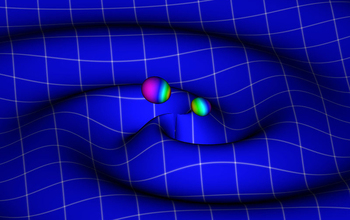Multimedia Gallery
Gravitational waves detected for third time
For the third time, the Laser Interferometer Gravitational-wave Observatory (LIGO) detected gravitational waves, ripples in space and time, demonstrating that the detection of gravitational waves may soon become commonplace. This image shows a collision of two black holes with masses of 28 to 36 and 21 to 28 times the mass of the sun, respectively. The spheres at the center represent the event horizons of the black holes. The size of the black holes has been increased by a factor of 4 to enhance visibility. Elevation and color of the surface gives an indication of the strength of the gravitational field at that point. Orange is strongest, dark blue is weakest. The collision happened between 1.1 and 2.2 billion light-years from Earth, and was observed from a direction near the Eridanus constellation. The mass equivalent of three suns was converted to gravitational radiation and radiated into space.
More about this image
This latest detection occurred during LIGO's current observing run, which began Nov. 30, 2016, and will continue through the summer. Its observations are carried out by twin detectors -- one in Hanford, Washington, and the other in Livingston, Louisiana -- operated by Caltech and MIT with funding from the National Science Foundation (under grant PHY 07-57058).
In all three cases, each of the twin detectors of LIGO detected gravitational waves from the tremendously energetic mergers of black hole pairs. These are collisions that produce more power than is radiated as light by all the stars and galaxies in the universe at any given time.
The recent detection appears to be the farthest yet, with the black holes located about three billion light-years away. The black holes in the first and second detections are located 1.3 and 1.4 billion light-years away, respectively.
To learn more about this research, see the NCSA news story LIGO detects gravitational waves for third time. (Date image taken: October 2017 date originally posted to NSF Multimedia Gallery: Feb. 27, 2018)
Credit: NCSA Gravity Group
Images and other media in the National Science Foundation Multimedia Gallery are available for use in print and electronic material by NSF employees, members of the media, university staff, teachers and the general public. All media in the gallery are intended for personal, educational and nonprofit/non-commercial use only.
Images credited to the National Science Foundation, a federal agency, are in the public domain. The images were created by employees of the United States Government as part of their official duties or prepared by contractors as "works for hire" for NSF. You may freely use NSF-credited images and, at your discretion, credit NSF with a "Courtesy: National Science Foundation" notation.
Additional information about general usage can be found in Conditions.
Also Available:
Download the high-resolution JPG version of the image. (208.0 KB)
Use your mouse to right-click (Mac users may need to Ctrl-click) the link above and choose the option that will save the file or target to your computer.



